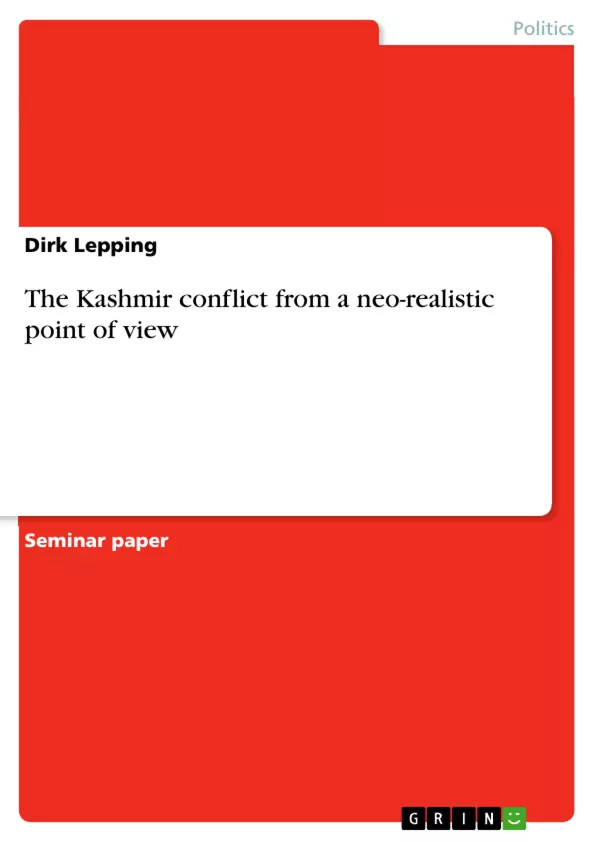After the dreadful tragedy that happened in New York on 11 September, the world had to redefine the extent of terrorism. In this context there is one conflict that is gradually turning over to be an explosive powder keg. It is the Indo-Pakistan conflict about the area called "Kashmir". Ever since the British colonial power ended in 1947 and the Muslim League demanded the partition of India and Pakistan, there has been a smouldering conflict between Pakistan and India about ′the bone of contention′ Kashmir. Pakistan and India have always been irreconcilably divided in the most important aspects such as religion, culture, economic interests and the social system. From neo-realistic point of view, this conflict bears numerous factors that gave rise to it and influenced its development. The underlying assumption is that the problems at issue were predictable and, hence, maybe could have been fought against earlier and more determined.
Having a look at the common history of India and Pakistan, it has obviously always been a conflict between Muslims and Hindus and, on the other hand, between different cultures within these confessions. It just all turned out to be explosive when, they had to decide about India′s independence in 1947. Although these negotiations were without doubt a risky question of gaining and loosing power, the negotiation partners found a reasonable and ostensibly peaceful solution by splitting British-India in the Hindu part of India and the northern, Muslim part, from then on called Pakistan. However, they could not have suspected that they sowed the seed of a terrible future conflict between the two powers-to-be.
Inhaltsverzeichnis (Table of Contents)
- The Kashmir conflict from a neo-realistic point of view
- India and Pakistan - A History of Conflicts
- The Partition of India and Pakistan
- Kashmir and Jammu - A Princely State in Conflict
- The Security Dilemma and the Partition of Kashmir
- The Muslim Struggle for Freedom
- The Escalation of the Conflict
- Conclusion
Zielsetzung und Themenschwerpunkte (Objectives and Key Themes)
This paper analyzes the Indo-Pakistan conflict over Kashmir from a neo-realistic perspective. It aims to identify the underlying factors that contributed to the conflict and its development, arguing that the issues at play were predictable and could have been addressed earlier.
- Historical context of Muslim-Hindu relations in the region
- The role of the partition of India and Pakistan in creating a security dilemma
- The impact of different historical interpretations on the conflict
- The influence of nationalism, fundamentalism, and power dynamics on the conflict
- The complexities of the conflict and the difficulty of finding a lasting solution
Zusammenfassung der Kapitel (Chapter Summaries)
- The Kashmir conflict from a neo-realistic point of view: This chapter introduces the Kashmir conflict and its significance in the context of global terrorism. It presents a neo-realistic perspective on the conflict, highlighting the historical tensions and power dynamics that contribute to its persistence.
- India and Pakistan - A History of Conflicts: This chapter explores the historical relationship between India and Pakistan, highlighting the long-standing conflicts rooted in religious differences, cultural clashes, and contrasting economic interests. It sets the stage for understanding the complexities of the Kashmir conflict.
- The Partition of India and Pakistan: This chapter analyzes the process of the partition of British India into India and Pakistan in 1947. It examines the challenges of negotiating independence and the problematic nature of princely states with differing populations and rulers. The chapter emphasizes the role of the partition in creating a climate of distrust and insecurity.
- Kashmir and Jammu - A Princely State in Conflict: This chapter focuses on the specific case of Kashmir and Jammu, a princely state with a Muslim majority and a Hindu ruler. It explores the difficulties of determining the state's future and the competing claims of India and Pakistan. The chapter discusses the role of population distribution and religious identities in shaping the conflict.
- The Security Dilemma and the Partition of Kashmir: This chapter analyzes the security dilemma that emerged from the partition, highlighting the distrust and insecurity felt by both India and Pakistan. It argues that both states took actions to enhance their security that ultimately contributed to the escalation of the conflict. This section also explores the impact of different versions of history and the complexities of the partition.
Schlüsselwörter (Keywords)
The main keywords and focus topics of this work are: Indo-Pakistan conflict, Kashmir, neo-realism, security dilemma, partition of India, princely states, Muslim-Hindu relations, nationalism, fundamentalism, power dynamics, terrorism, international relations.
- Quote paper
- Dirk Lepping (Author), 2002, The Kashmir conflict from a neo-realistic point of view, Munich, GRIN Verlag, https://www.grin.com/document/16001



